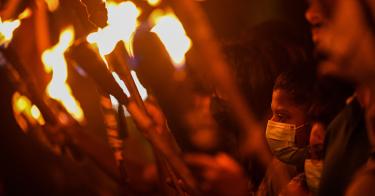It was rather remarkable: In the 21st century, no Asian country had defaulted on its sovereign debt. Until now.
For the past several months Sri Lanka, a small island nation off India’s southern coast straddling the region’s crucial waterways, has been embroiled in an economic and political crisis. It reached a crescendo in July, when street protests forced the resignation and hasty departure of President Gotabaya Rajapaksa.
The crisis arose from numerous problems. Among those highlighted by Akhil Bery of the Asia Society Policy Institute are: spiraling debt obligations; protectionist trade policies; runaway budget and trade deficits; unsound vanity infrastructure projects; nepotism and corruption; waning tax revenues; surging inflation; commodity price spikes; and a crippling blow to vital tourism and remittances revenues because of COVID-19.
Those formidable problems were compounded by a disastrous decision taken by President Rajapaksa last April when, “with no warning, and with no attempt to teach farmers how to cope with the change, [he] announced a ban on all synthetic fertilizers and pesticides.” Rice production and tea exports plummeted. Food prices surged. The government was forced to reverse the decision months later, draining government coffers to compensate affected farmers.
>>> The Serious Lack of Good Governance and Economic Freedom: Root Causes of Sri Lanka’s Ongoing Turmoil
The perfect storm began battering the Sri Lankan economy earlier this year. In March, Sri Lankan sovereign debt was downgraded to a “junk” rating. In April, Colombo suspended foreign debt payments. Amid supply shortages, power cuts, and rampant inflation, Sri Lankans took to the streets. Several government ministers, including some bearing the Rajapaksa name, resigned.
In May, Sri Lanka defaulted on its external debt and Prime Minister Mahinda Rajapaksa, Gotabaya’s brother and the country’s former president, resigned. Gotabaya soldiered on as president for two more months before abruptly departing the country via military aircraft, announcing his resignation afterward.
After winning a special election in parliament, moderate former (six-time) prime minister Ranil Wickremesing will, for now, serve as president. He inherits a dire situation. Year-on-year inflation is approaching 60%. The country is out of hard currency, and the World Bank won’t offer new financing to Sri Lanka until Colombo implements adequate macroeconomic policy reforms. Wickremesinghe has pinned his hopes on the IMF: in a few weeks he intends to submit a debt restructuring and funding plan to secure the billions of dollars Sri Lanka needs to stay afloat.
The crisis has refocused attention on China’s growing role in Sri Lanka. During Mahinda Rajapaksa’s reign as president (2005-2015), China made headlines with several splashy, controversial, multi-billion dollar investments in Sri Lanka, including the $1.5 billion port and airport in the remote district of Hambantota, the ancestral home of the Rajapaksas. Both operate at a loss. The $200 million airport has been dubbed “The World’s Emptiest International Airport.”
Unable to repay the Chinese loans, in 2017 Sri Lanka leased the port to Chinese state-owned entities for 99 years. The deal was suspicious. The Sri Lankan government later forced the removal of sovereignty-violating provisions from the agreement. The Sri Lankan government is also on the hook for the Chinese-financed $1.5 billion Colombo Port City project, a large stake of which is also on a 99-year lease to Chinese state-owned entities.
Is the Chinese “debt trap” responsible for Sri Lanka’s current crisis? Yes and no. China has certainly compounded Sri Lanka’s economic woes through irresponsible lending. But it is not solely responsible. International sovereign bonds purchased on the open market are the largest source of Sri Lanka’s external debt. Mismanagement by the Sri Lankan government bears a good deal of the blame, as does the pandemic and inflationary pressures largely outside its control.
Yet, China is far from blameless. First, many of the concerns aired about China’s growing footprint in Sri Lanka extend beyond macroeconomic malpractice. It has been accused of fueling corruption and nepotism, illegally funneling money to pro-Chinese politicians, reinforcing the Rajapaksa’s undemocratic instincts, and inserting sovereignty-violating provisions into billion-dollar deals negotiated in secret.
Second, China is Sri Lanka’s largest bilateral creditor, and it loaned the country billions of dollars for vanity projects that other bilateral and international lenders had rejected for a reason. It is also consuming an ever-larger share of Sri Lanka’s debt profile. Most reports suggest China accounts for roughly 11% of Sri Lanka’s external debt, but newer estimates put the figure closer to 20-26% when accounting for Chinese commercial lending to the government and Sri Lankan state-owned enterprises.
The IMF insists Colombo needs to talk to China about restructuring its debt, but thus far Beijing is playing hardball. Facing its own economic- and pandemic-related troubles at home, China has been reluctant to bail out drowning partners in the developing world. This spring, Beijing refused a Sri Lankan request for a $2.5 billion credit support facility and rescinded Sri Lanka’s access to a $1.5 billion swap line.
India has stepped up, providing Sri Lanka over $4 billion in economic assistance this year, including currency swaps and credit lines. India has watched China’s growing footprint in Sri Lanka with alarm.
>>> Tunisia Backslides From Arab Spring to Autocracy
Like his brother Mahinda, President Gotabaya Rajapaksa tilted toward China early in his term, taking on billions of dollars in new Chinese loans in 2020 to pay off old Chinese loans. In 2021, the president scrapped an existing agreement to offer Indian and Japanese companies a development contract for the East Container Terminal at the Colombo Port, handing the deal to a Chinese company instead.
The pendulum may now be swinging back India’s way. This March, India and Sri Lanka signed a deal to create a Maritime Rescue Coordination Center in Colombo, with a second site in Hambantota. President Wickremesinghe will likely be eager to strike a more delicate balance, enhancing cooperation with the U.S. and the West while assuaging Indian security concerns about China’s growing profile on the island.
This month, news emerged that a Chinese survey and spy vessel was en route to Hambantota. The Wickremesinghe government insisted the visit had been cleared by President Gotabaya Rajapaksa one day before he fled the country and that the Chinese ship was coming only to refuel. The Indian government nevertheless expressed its displeasure, suggesting it was monitoring the situation and would protect its security and economic interests. Sri Lanka then asked China to postpone the visit, prompting a protest from Beijing. In a second about-face, Colombo then re-approved the port call for the Chinese vessel, and the tug-of-war continues.
Over the past 15 years, Sri Lanka has arguably been South Asia’s hottest battleground state, a microcosm of a broader regional struggle for influence and access underway between China and India. Moving forward, New Delhi and Washington should work together, and in partnership with international lenders, to provide Sri Lanka the debt relief it needs to avoid a calamitous disintegration of its economy. At the same time, they must encourage the Sri Lankan government to make the difficult reforms needed to put the country on a sustainable path as a sovereign, democratic, economically vibrant member of the Indo-Pacific community.
This piece originally appeared in RealClear World




